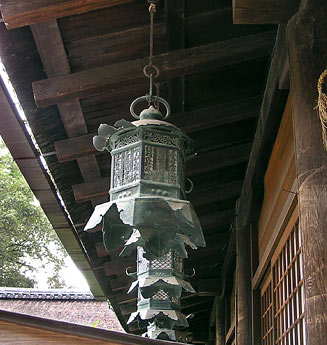|
||
 |
||

Kasuga
Taisha tϊεΠ (Nara)
@
(C)2001 Japanese Architecture and Art Net Users System.@No reproduction or republication without written permission.
fΪΜeLXgEΚ^ECXgΘΗASΔΜRecΜ³f‘»E]ΪπΦΆά·B
|
||||||
| @ | ||||||
| tsuridourou@ήβΔ | ||||||
| KEY WORD :@architecture / lanterns | ||||||
| @ | ||||||
| Also *kaitomoshi ~. A lantern hung from the corner of the eaves of a building. They are usually small, 4-or 6-sided, and made from metal, copper or wood. The lantern is designed to fit under the overhanging eaves of the roof; the shape is often curved, with the portion under the flame holder being wider and the area above narrower. The lanterns have a long history dating back to ancient China. They were introduced to Japan in the Nara period for use in imperial palaces; later these hanging lanterns were called *tourouβΔ ; they were also termed akashi and miakashi δ. Hanging lanterns exist today in the Seiryouden ΄Αa and Higyousha ςΙ of Kyoto Gosho sδ. | ||||||
| @ | ||||||
 Kasuga
Taisha tϊεΠ (Nara)
|
||||||
@ |
||||||
| REFERENCES: | ||||||
| @ | ||||||
| EXTERNAL LINKS: | ||||||
| @@ | ||||||
| NOTES: | ||||||
| @ | ||||||
(C)2001 Japanese Architecture and Art Net Users System.@No reproduction or republication without written permission. fΪΜeLXgEΚ^ECXgΘΗASΔΜRecΜ³f‘»E]ΪπΦΆά·B |
||||||
| @ |